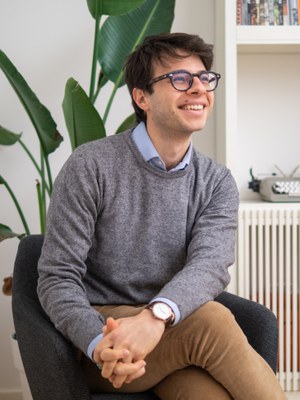Romio Francesco Axel Pio
XXXIX Cycle IDAUP (A. Y. 2024-2025)
 Curriculum: Architecture
Curriculum: Architecture
Topic: 2.3 Territory, landscape, and regeneration of the built-up environment: infrastructural interventions, new energy sources, and climatic change | 2.3 Territorio, paesaggio e rigenerazione del l'ambiente costruito: interventi infrastrutturali, nuove fonti energetiche e cambiamento climatico;
Home Institution: University of Ferrara
Disciplinary sector: CEAR-9/B
Main Supervisor: Dr. Gianni Lobosco
Co-Supervisor: Prof. Ledian Bregasi
External Expert(s): Prof. Henriette Bier
ORCID ID: 0009-0003-0504-3077
SFERA ID: https://sfera.unife.it/cris/rp/rp119967
Concise CV (English version)
Francesco Axel Pio Romio is a licensed architect with expertise in Space, Landscape, and Humanitarian Architecture. He is currently a PhD candidate at the University of Ferrara and Polis University of Tirana, as well as a Guest Visiting Researcher at the Robotic Building Lab of TU Delft. His research focuses on the use of lunar and Martian lava tubes for space settlements and on the technological transfer of space innovations for sustainable terrestrial planning. Since 2021, he has been part of the Sealine Research Centre, and since 2022, he has collaborated with YAC and YACademy on various initiatives related to landscape and space, including organizing one of the first courses in Italy and globally on this topic. From 2022 to 2023, he was part of the international architectural collective PSR. He writes about space and architecture for Astrospace.it.
Concise CV (Italian version)
Francesco Axel Pio Romio è architetto abilitato con competenze nei settori Space, Landscape e Humanitarian Architecture. Attualmente è dottorando presso l'Università di Ferrara e la Polis University di Tirana e Guest Visiting Researcher presso il Robotic Building Lab di TU Delft. La sua ricerca esplora l’utilizzo di tubi di lava lunari e marziani per insediamenti spaziali e il trasferimento tecnologico spaziale per la pianificazione terrestre sostenibile. Dal 2021 è parte del Sealine Research Centre e dal 2022 collabora con YAC e YACademy, su diverse iniziative relative al paesaggio e allo spazio, organizzando uno dei primi corsi in Italia e al mondo sul tema. Nel 2022-2023 è stato parte del collettivo internazionale di architetti PSR. Scrive di spazio ed architettura per Astrospace.it
Research proposal (English version)
Title: Architecture, Habitability, and Well-being in Extreme Environments on Earth and in Outer Space
Description: In the context of current efforts for future space exploration, particularly within the “Artemis Program,” one of the key challenges for space agencies is to establish a sustainable human presence on the Moon. This would not only support ongoing research but also serve as a testbed for future Martian exploration. Lunar and Martian surfaces pose extreme hazards, including micrometeorite impacts, radiation, temperature extremes, and toxic dust, which represent constant threats to astronauts. Recent evidence suggests the presence of volcanic caves, or “lava tubes,” beneath the surfaces of both bodies. These structures could offer protection from surface hazards, yet their interiors remain unexplored. The present research employs Remote Sensing technologies, computational tools, and parametric methods to investigate and develop strategies for adapting and inhabiting these underground spaces. Collaborating with the Robotic Building Lab of TU Delft and the Department of Geosciences at Padua, the project seeks to advance the characterization of lava tubes and their architectural potential, providing new tools for stakeholders such as space agencies and universities. Additionally, the research explores the application of similar technologies to foster sustainable Earth planning.
Keywords: Lava tubes, Space Architecture, Earth Observation, Remote Sensing, Landscape
Research proposal (Italian version)
Titolo: Architettura, abitabilità e benessere in ambienti estremi sulla Terra e nello spazio
Descrizione: Nel contesto degli attuali sforzi per l’esplorazione spaziale futura, in particolare all’interno del “Programma Artemis,” una delle principali sfide per le agenzie spaziali è stabilire una presenza umana sostenibile sulla Luna. Questo obiettivo non solo supporterebbe la ricerca in corso, ma fungerebbe anche da banco di prova per le future esplorazioni su Marte. Le superfici lunare e marziana presentano pericoli estremi, tra cui impatti di micrometeoriti, radiazioni, temperature estreme e polveri tossiche, che rappresentano minacce costanti per gli astronauti. Recenti evidenze suggeriscono la presenza di grotte vulcaniche, o “tubi di lava,” sotto le superfici di entrambi i corpi celesti. Queste strutture potrebbero offrire protezione dai pericoli superficiali, ma i loro interni rimangono inesplorati. La presente ricerca utilizza tecnologie di Remote Sensing, strumenti computazionali e metodi parametrici per indagare e sviluppare strategie di adattamento e abitabilità di questi spazi sotterranei. Collaborando con il Robotic Building Lab di TU Delft e il Dipartimento di Geoscienze dell’Università di Padova, il progetto mira a far progredire la caratterizzazione dei tubi di lava e il loro potenziale architettonico, fornendo nuovi strumenti a stakeholder come agenzie spaziali e università. Inoltre, la ricerca esplora l’applicazione di tecnologie simili per promuovere una pianificazione sostenibile sulla Terra.
Parole chiave: Tunnel lavici, Architettura Spaziale, Osservazione della Terra, Telerilevamento, Paesaggio
